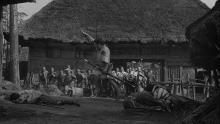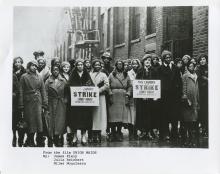These notes on Apichatpong Weerasethakul's Tropical Malady were written by Zachary Zahos, PhD student in UW-Madison’s Department of Communication Arts and Project Assistant for the UW-Cinematheque. A 35mm print of Tropical Malady, courtesy of the UCLA Film & Television Archive, will screen in our regular venue, 4070 Vilas Hall, on Friday, November 22 at 7 p.m. Admission is free!
By Zachary Zahos
Last month, October 2019, Apichatpong Weerasethakul’s production company Kick the Machine wrapped shooting for his upcoming film Memoria. Production began late August in Colombia, with an international cast that includes Tilda Swinton, Jeanne Balibar (The Duchess of Langeais), and Daniel Giménez Cacho (Zama). Just two weeks ago at the 2019 American Film Market (AFM), film distributor Neon acquired North American rights for Weerasethakul’s latest, ahead of its expected 2020 European film festival (likely Cannes) debut. As it happens, Neon’s deal echoes its strategy for Bong Joon-ho’s Parasite, which it acquired at last year’s AFM months before its premiere at Cannes, where it won the Palme d’Or.
All this amounts to a number of firsts for Weerasethakul, or “Joe,” as Anglophone cinephiles like to call him: the first time he has filmed outside of his native Thailand; the first time he has worked with a star like Swinton; the first time a specialty distributor with a track record of commercial success (Parasite’s $14.5 million domestic haul as of this writing) has jumped on one of his films. In addition, the five years between Cemetery of Splendor (2015) and Memoria will be the longest gap between features since Weerasethakul opened his career with Mysterious Object of Noon in 2000. On paper, these factors might prompt one to ask: Will Memoria usher in a new, more mainstream phase of Weerasethakul’s career? Has Joe changed?
We must patiently wait for Memoria’s release to answer this question, of course, but anyone familiar with Weerasethakul’s work has reason to believe commercial viability is neither his aim nor strong suit. Thailand’s most famous auteur practices an undivided kind of art cinema, one characterized by its languid pace, dense soundscapes, supernatural subject matter, and a disjunctive mix of tropical and urban-modern Thai settings. He has amassed his wealth in Western cultural capital, earning his MFA from the Art Institute of Chicago and winning three major prizes from Cannes: the 2002 Un Certain Regard Award for Blissfully Yours, the 2004 Jury Prize for Tropical Malady, and the 2010 Palme d’Or for Uncle Boonmee Who Can Recall His Past Lives. More than most art film auteurs, Weerasethakul has also developed a reputation as a gallery artist, having made video installations and over 30 short films. His reputation reaches around the globe, from New York to Berlin to Japan to the U.A.E., though his films have received restricted releases in Thailand and are reportedly not well-received in Bangkok.
So, Apichatpong Weerasethakul is neither a commercial filmmaker nor one officially championed by his homeland. Faced with such a gap, critics have charged Weerasethakul of catering to “Western sensibilities” and of being insufficiently Thai—analogous to the treatment of Abbas Kiarostami by some Iranian intellectuals and Western critics throughout his career.
This line of critique withers when confronted with a film like Tropical Malady. On a narrative level alone, Weerasethakul filters Thai political history and animist folktales through his own queer perspective. This film tells the story of soldier Keng (Banlop Lomnoi) and village boy Tong (Sakda Kaewbuadee), who fall in love in the relatively straightforward opening hour. The cryptic second hour seemingly resets the narrative, as Keng plods through the jungle in search of a tiger spirit, or werecat. This spirit, it turns out, takes multiple appearances, the human one looking like Tong. During the contemplative climax, Keng confronts Tong’s tiger form, and Weerasethakul visualizes this meeting via a traditional-style Thai painting, which depicts a tiger extending its serpentine tongue toward a man kneeled in prayer. The power of the film’s ending hinges on a metaphysical conceit, as Keng weighs his love for Tong. This inner struggle is conveyed through a remarkable shot reverse shot sequence of close-ups between Keng, who registers a whole gamut of emotion before emptying to a Bressonian blankness, and Tong, who is literally a living, panting tiger. Gilles Deleuze once said close-ups reveal “the nudity of the face much greater than that of the body, an inhumanity much greater than that of animals,” and that sentence made no sense until I saw the ending of Tropical Malady.
Such a daring and gorgeous study of Thailand’s land and history has, naturally, opened Weerasethakul to charges of exoticism. Among Anglophone critics, this line of attack has likely been assisted by his admirers, who have drawn comparisons between his work and orientalist or primitivist art. In Thailand, the response to Tropical Malady was more than diverse than might be presumed, with the hostility in fact concentrated in Bangkok, the country’s intellectual and political capital.
In a 2009 essay recently republished by Verso, the late Benedict Anderson studied the domestic Thai reception of Tropical Malady and found it to be cherished in multiple regions outside Bangkok. About an hour outside the capital, Anderson visited legitimate video stores and bootleg DVD kiosks selling Tropical Malady to appreciative customers, some who were queer and some who never before fathomed of gay love. According to Anderson, many “up-country” (khon baan nork) people, who spend more time by rainforests than their city counterparts, also have taken to the film. For all his global-metropolitan cachet today, Weerasethakul hails from Khon Kaen, a rural province of Isan. Bordering Laos, Isan is Thailand’s northeastern, “up-country” region, viewed as ethnically and culturally distinct from Bangkok.
In Bangkok, Anderson speculated that the bourgeois intellectual class (who are mainly children of Chinese and Sino-Thai) disapprove of Tropical Malady “because it presents a form of ‘Thai culture’ with ancient roots that is ‘below them’ as well as alien to their experience. To be able to dismiss it as ‘meant for Westerners’ is to show one’s own patriotic Thai credentials against the implicit threat that the film provides.” Anderson also claimed Thailand state censors hold dismissive and paternalistic views toward “up-country” people, an assertion backed by the state's notorious restriction of Weerasethakul’s 2006 film Syndromes and a Century. This leaves Tropical Malady in the awkward position of being too many things at once: too Western, too Isanese, too intellectual, too provincial, too slow, too queer. Everything but commercial! In other words, one of our young century’s essential films.







